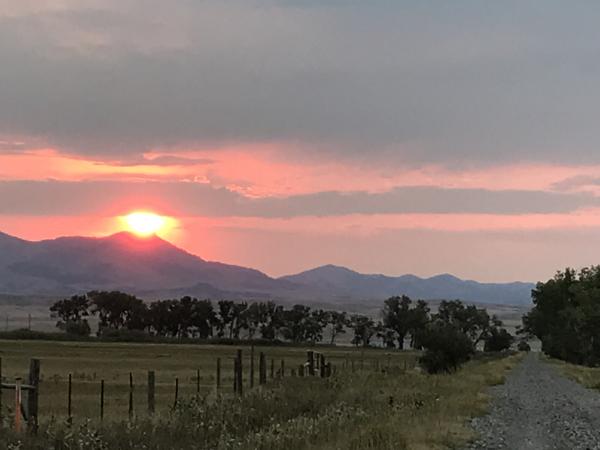The past two weeks since I last wrote have been filled with morning mist hovering over the lake waters, long walks serenaded by grasshoppers, and brilliant red sunrises and sunsets. The beauty of early September makes evident why the Ecumenical Patriarch Dimitros first proclaimed September 1st as the Orthodox Day of Prayer for Creation back in 1989, and why his initial effort has been joined by so many other faith communities around the globe that now the whole month—through the feast of St. Francis of Assisi on October 4th—has been named the Season of Creation.
But those gorgeous views that I’ve been enjoying also indicate part of the reason we so desperately need to mark a Season of Creation. There shouldn’t be that many grasshoppers on the Montana Hi-line right now. Ordinarily their reign would have been quelled by a frost at this point. And the skies shouldn’t be that red. It is the smoke from wild fires in Glacier National Park that painted the horizon cerise. Indeed, just a few days after I went hiking in the Bear Paw Mountains the area near where I was walking went up in flame. If you want to pray with a hauntingly beautiful yet devastating song this month, check out “All Creatures Lament”—a newly released re-write of the classic hymn “All Creatures of Our God and King.”
One of the great gifts of the month for me is that it is allowing me to do a slow, deep study of the creation stories from Genesis. I’ve been reading the opening pages of Etz Hayim – the Torah commentary put out by the Rabbinical Assembly—so interesting (though I do wish I knew Hebrew!) And then I just finished Barbara Brown Taylor’s The Luminous Web: Essays on Science and Religion. Beautifully written… as is everything BBT writes. I’ll close with one of the stories she relays there about a research meteorologist in the 1960’s named Edward Lorenz who was trying to figure out how to make weather predicting more… well, predictable. If we can figure out the path comets decades before the return, why can’t we reliably know if it is going to rain next Tuesday?
Lorenz arrived at twelve algorithms based on ratios observed in the natural world (i.e the relationship between temperature and barometric pressure, between barometric pressure and wind speed, etc…) His computer was able to identify clear patterns in the weather based on these algorithms, but even as he entered the same variables, he was never able to get the patterns to replicate themselves exactly. There was always a bit of fluctuation in the resulting weather. One day he decided to take a short cut and truncate one of the variable numbers he was entering from .506127 to .506 and went to get a cup of coffee. When he returned, he found a weather pattern so different that threw all the mild variations he’d spotted earlier entirely out of whack.
As Brown Taylor notes, “He had assumed that the difference between the two--.000127—was inconsequential, but that was where he was wrong. That tiny number, way down in the thousandths—as far as the weather was concerned, a puff of wind no bigger than a baby’s sneeze or the beat of a butterfly’s wings—that tiny little change at the beginning of a weather system turned out to be the difference between a blue sky and a monsoon.”
Lorenz’ discovery could be a bit depressing because we realize our every poor choice could have ramifications so far beyond what we can imagine. But it also should be exhilarating because it implies every small effort we make on behalf of our planet could also change….well, everything.
